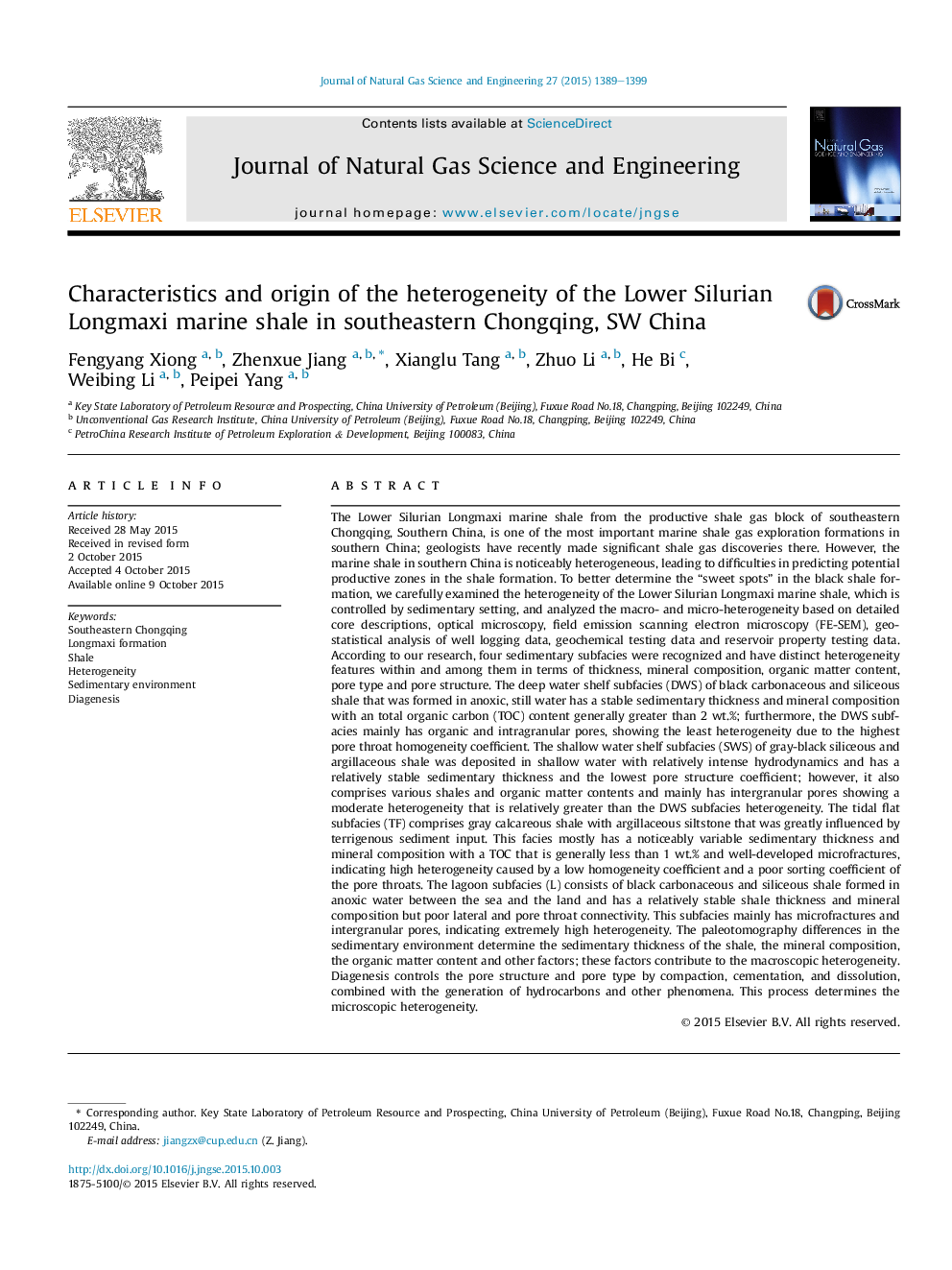| کد مقاله | کد نشریه | سال انتشار | مقاله انگلیسی | نسخه تمام متن |
|---|---|---|---|---|
| 10690328 | 1019124 | 2015 | 11 صفحه PDF | دانلود رایگان |
عنوان انگلیسی مقاله ISI
Characteristics and origin of the heterogeneity of the Lower Silurian Longmaxi marine shale in southeastern Chongqing, SW China
دانلود مقاله + سفارش ترجمه
دانلود مقاله ISI انگلیسی
رایگان برای ایرانیان
کلمات کلیدی
موضوعات مرتبط
مهندسی و علوم پایه
علوم زمین و سیارات
علوم زمین و سیاره ای (عمومی)
پیش نمایش صفحه اول مقاله

چکیده انگلیسی
The Lower Silurian Longmaxi marine shale from the productive shale gas block of southeastern Chongqing, Southern China, is one of the most important marine shale gas exploration formations in southern China; geologists have recently made significant shale gas discoveries there. However, the marine shale in southern China is noticeably heterogeneous, leading to difficulties in predicting potential productive zones in the shale formation. To better determine the “sweet spots” in the black shale formation, we carefully examined the heterogeneity of the Lower Silurian Longmaxi marine shale, which is controlled by sedimentary setting, and analyzed the macro- and micro-heterogeneity based on detailed core descriptions, optical microscopy, field emission scanning electron microscopy (FE-SEM), geostatistical analysis of well logging data, geochemical testing data and reservoir property testing data. According to our research, four sedimentary subfacies were recognized and have distinct heterogeneity features within and among them in terms of thickness, mineral composition, organic matter content, pore type and pore structure. The deep water shelf subfacies (DWS) of black carbonaceous and siliceous shale that was formed in anoxic, still water has a stable sedimentary thickness and mineral composition with an total organic carbon (TOC) content generally greater than 2Â wt.%; furthermore, the DWS subfacies mainly has organic and intragranular pores, showing the least heterogeneity due to the highest pore throat homogeneity coefficient. The shallow water shelf subfacies (SWS) of gray-black siliceous and argillaceous shale was deposited in shallow water with relatively intense hydrodynamics and has a relatively stable sedimentary thickness and the lowest pore structure coefficient; however, it also comprises various shales and organic matter contents and mainly has intergranular pores showing a moderate heterogeneity that is relatively greater than the DWS subfacies heterogeneity. The tidal flat subfacies (TF) comprises gray calcareous shale with argillaceous siltstone that was greatly influenced by terrigenous sediment input. This facies mostly has a noticeably variable sedimentary thickness and mineral composition with a TOC that is generally less than 1Â wt.% and well-developed microfractures, indicating high heterogeneity caused by a low homogeneity coefficient and a poor sorting coefficient of the pore throats. The lagoon subfacies (L) consists of black carbonaceous and siliceous shale formed in anoxic water between the sea and the land and has a relatively stable shale thickness and mineral composition but poor lateral and pore throat connectivity. This subfacies mainly has microfractures and intergranular pores, indicating extremely high heterogeneity. The paleotomography differences in the sedimentary environment determine the sedimentary thickness of the shale, the mineral composition, the organic matter content and other factors; these factors contribute to the macroscopic heterogeneity. Diagenesis controls the pore structure and pore type by compaction, cementation, and dissolution, combined with the generation of hydrocarbons and other phenomena. This process determines the microscopic heterogeneity.
ناشر
Database: Elsevier - ScienceDirect (ساینس دایرکت)
Journal: Journal of Natural Gas Science and Engineering - Volume 27, Part 3, November 2015, Pages 1389-1399
Journal: Journal of Natural Gas Science and Engineering - Volume 27, Part 3, November 2015, Pages 1389-1399
نویسندگان
Fengyang Xiong, Zhenxue Jiang, Xianglu Tang, Zhuo Li, He Bi, Weibing Li, Peipei Yang,